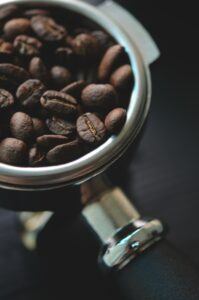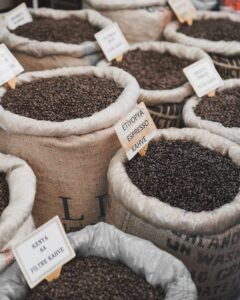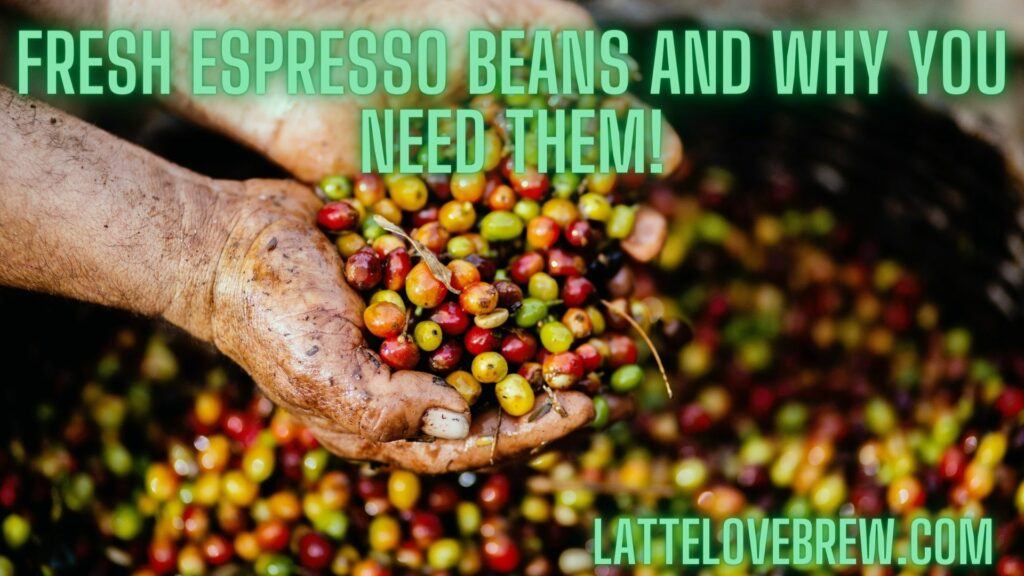Last updated on December 4th, 2023 at 13:28
You’ve heard people talking about fresh espresso beans many times but have you ever considered why you need to use the freshest ones that you can find?
This article will address that very topic and everything that you need to know about fresh espresso beans, what type, blends and just about everything you can think of!
… Still, if you have any questions that I have not addressed – ask it, and they will be answered! This article, after all, is for you and is designed to be the ultimate guide and get you making the most distinctive strong coffee in the world.
What Are Espresso Coffee Beans?
Table Of Contents
- 1 What Are Espresso Coffee Beans?
- 2 Why Use Fresh Espresso Roasted Beans?
- 3 How Fresh Do Espresso Beans Need To Be?
- 4 What Is Unique About Espresso Coffee Beans?
- 5 Buying Tips For Freshly Roasted Espresso Beans
- 6 Fresh Espresso Beans And The Most Interesting Coffee Growing Regions
- 7 Getting The Best Out Of Your Fresh Espresso Beans
- 8 What Are The Best Beans For An Espresso?
- 9 Whole Beans vs Pre-ground Beans
- 10 What Is The Grind Size For Espresso Beans?
- 11 A Blend Or Single Origin?
- 12 Does An Espresso Coffee Need To Be Dark Roasted?
- 13 Why Do Coffee Grounds Need To Degas?
- 14 Frequently Asked Questions About Fresh Espresso Beans
- 14.1 How Fresh Should Beans Be For Espresso?
- 14.2 What Kind Of Beans Are Best For Espresso?
- 14.3 How Long Do Fresh Espresso Beans Last?
- 14.4 Is There A Difference Between Coffee Beans And Espresso Beans?
- 14.5 What Beans Does Starbucks Use For Its Espresso?
- 14.6 How Much Espresso Does 20g Of Beans Make?
- 14.7 Can You Make Espresso With Fresh Beans?
- 14.8 How Fresh Is Too Fresh For Espresso?
- 15 Frappé-Ing It All Up – Fresh Espresso Beans
Technically and strictly speaking, there is no such thing as an Espresso bean as such. “Espresso” is a roast which means that any bean can become an espresso bean by means of the roasting process.
The espresso roasting process takes any green coffee bean, which all coffee beans start out as green beans, and turns them into an espresso bean by roasting them at 464° F (240° C) for approximately 10 minutes.
An espresso is a dark roast bean that has that deeper, darker, more traditional coffee flavor, less acidic and more chocolaty and nutty flavors coming through.
This roast profile looses the complex flavor associated with a specific geographic location and, thus your specialty single origin beans are best not used for making an espresso roast. These are best as medium roasts and light roasts. Due to the roasting process, an espresso takes on a fruity flavor comparable to flavors of chocolate with some claiming flavors of milk chocolate due to enjoying milk in their coffee.
An espresso is also normally ground to a very fine powder like grind to produce the famed coffee drink.
Contrary to common thought, the caffeine content and caffeine kick of espresso beans and an espresso coffee is less than other roasts.

Read: Fastest brewing coffee maker
Why Use Fresh Espresso Roasted Beans?
The reason for using fresh espresso roasted beans is obvious — fresh beans mean fresher, better tasting coffee. This is the solid, hard and fast rule for all coffee beans — fresh is best.
At Latte Love Brew we encourage you to do your own roasting. Home roasting will ensure maximum freshness and peak flavor. Fresh grinding and fresh roasting will help you get the freshest and best tasting coffee.
Coffee that is not fresh has a loss of aroma and starts to lose its fresh sweet, warm scent and even starts to smell a little stale and the carbon dioxide build up from the beans starts to increase.
Maximum freshness in your coffee beans means maximum taste in your cup and that is why we must use fresh roasted coffee beans to make truly amazing coffee.

Read: how to be a barista at home
How Fresh Do Espresso Beans Need To Be?
Since fresh is best, the natural next question is just how fresh do your espresso beans need to be?
Ideally,
you should be grinding and brewing your beans no earlier than 3 days after roasting and no later than 10 days for maximum freshness. This is the peak freshness and peak flavor window.
That’s a 7-day window after the 3-day post roasting window. You could push an extra 3 to 7 days. It is this short window that encourages me to get readers into the home roasting revolution.
Do not brew your beans inside that initial 3-day window as they will be high in carbon dioxide and giving off a lot of gas which is detrimental to the flavor profile.
What Is Unique About Espresso Coffee Beans?
Espresso coffee beans are unique due to its roast profile and intense flavor. Very few roasts have the depth of flavor and intensity of an espresso without a slight ash flavor or burnt-like taste which you can associate with Italian roasts and French roasts.
Also, an espresso roast can be used for a wide range of drinks, such as a flat white to a latte and everything in-between. The complex flavor profile of an espresso coffee beans can come through using a variety of brewing methods, from drip coffee, percolator, moka pot, French press and more.
An espresso is simply not something that you can call regular coffee beans. That certain “espresso experience” and taste is not something that can be brewed up using regular beans or medium roast.
Also, what stands out about espresso beans is that they work very well when you are brewing a milk-based drink like a flat white, a latte, a cortado or a cappuccino. This is something that lighter roasts and medium roast coffees can’t do is cut through that curdy-creaminess that comes with adding milk to coffee. Only dark roast coffee beans can achieve this.
Despite the good strong taste associated with a fresh roasted coffee made with espresso beans they are cheaper, less expensive than specialty coffee like single origin coffee beans, blonde roasts. Due to the universality of espresso roasts and a darker roast in general, you can use them to make a number of different coffee drinks.

Buying Tips For Freshly Roasted Espresso Beans
If you are buying and not quite yet wanting to take up the hobby of home roasting, then probably the biggest and best tip anyone can give you regarding buying espresso beans and any coffee beans for that matter is to buy in small quantities and buy them often.
Also,
and just as important, is to look for the “roasted on date” on the bag. Buy the date nearest to today’s date, the date you are buying them. Completely optional is to buy them from your local artisanal coffee roasters and get to know them as they will know exactly how you like your roast to be and make it exactly as you like it to be.
Plus, if you are running out, you can call them a few days in advance and get them with the range of flavors that you love.
When you are buying your beans, try to get the best quality beans that you can and focus on the bag. Ensure that they are foil packed in an airtight ziplock bag with a one-way valve.
When the beans are stored in a bag that meets these requirements, you know they are fresh, can be kept fresh and will allow the carbon dioxide being emitted from the beans to escape through the one way valve while inhibiting oxygen and air to enter.
I strongly urge you to consider getting a proper coffee canister that is dark, does not permit strong light to enter at all and has a one way valve and has an airtight seal. This is far better than storing them in the bag they come in and will help to maintain the freshness of your beans.
Speaking of storage, regardless, I always store my coffee beans in my canister in the fridge for ultimate freshness.
Oxygen, light, heat and strong odors are detrimental to your beans and will result in a degradation of their quality.
Never buy beans that are openly exposed to the air or light in the place you are buying them, as these will obviously be past their best and not stored in optimal conditions.
Finally,
buy whole beans and grind your own, as this will only add to the freshness factor and enhance the taste. Fresh coffee is a combination of freshly roasted beans and freshly ground beans. Never forget coffee is a food product and freshness is VIP, like other food products they can and will go off.
Fresh Espresso Beans And The Most Interesting Coffee Growing Regions
While it is obvious, the better the beans, the better your coffee will be. Getting to know coffee and where the best dark roasts are grown will help you to make your coffee stand out in flavor, head and shoulders above what is sold in your local coffee shop.
Coffee is somewhat like wine where different vineyards and countries have their own flavor profile due to the same variables — climate and soil, which result in a unique flavor and aroma. Coffee plantations are no different from vineyards in this aspect.
Sumatra in Indonesia produces one of the best beans for a high quality dark roast, which an espresso roast, carries with it very mushroom-like earthy flavor notes almost like enjoying summer, freshly barbecue roasted mushrooms hint to your coffee. Smoky, and great, yet not ash like at all.
Even if you take Sumatra beans right the way up the roasting scale to a deep dark French roast, that taste still comes through.
It is impossible to talk about coffee roasts and regions without mentioning South American Coffees. The vast majority of coffees used for making an espresso in coffee shops across the world are usually middle of the road Brazilian coffee and of a medium roast and not, technically speaking, an espresso roast.
These coffees tend to have floral notes with a fruity flavor and hints of almond. You can brew up an outstanding shot of espresso using beans from all over Latin America like Panamanian, Colombian, Guatemalan and El Salvadorian beans.
The more famous Brazilian coffee beans have a more sweet taste, a chocolaty sweetness when pulling an espresso shot. When mixed in a blend of beans for espresso beans quite often, you will notice a nutty sweetness.
When it comes to dark roasts, one must, of course, mention the dark continent of Africa. A few of my favorite coffees come from here. Tanzanian, Kenyan and Ethiopian Coffee are often an absolute pleasure to drink. Even though a good part of their low temperature complex flavors are roasted out at the high temperatures used for dark roasts, you will still love them for espresso based drinks.
The African soil is high in mineral content and has a great climate for growing coffee. Notably, is the natural drying process method where the beans are sun dried, simply left to dry in the sun on their own.
Asia I have touched on earlier, with Indonesia being the stand-out location due to mostly being grown in volcanic soil, resulting in a bold, rich flavor. The best Indonesian beans are from Sumatra and will give you a full-bodied, rich cream espresso shot.
Vietnam, difficult to find, and predominantly a Robusta makes a very interesting and one of the strongest espresso blends.
Getting The Best Out Of Your Fresh Espresso Beans
Whichever espresso beans you decide on, there are a few techniques and tips to share to help you get the best out of your investment in quality beans.
The obvious part is having your own grinder, preferably a conical ceramic burr grinder or a mechanical hand grinder. Both will get you quality grounds and grind to the very fine grind that is needed for an espresso.
The reason for these two types of grinder is a manual grinder produces less heat, which spoils your grounds, and the ceramic conical burr grinder has a greater resistance to heat should you prefer an electric model.
You will need to set your grinder to a very fine grind and aim for at least a 100 micron grinder. While you will need at least a 100 micron grind size, this is achievable with most grinders on their finer setting. Smaller is not necessary but can be tried and experimented with depending on your taste and strength requirements.
The only coffee with a finer grind than an espresso is a Turkish coffee with a 50 micron grind size.
To brew up a great espresso you will need a good quality home espresso machine as you simply cannot make an espresso with a rich crema without a machine as you will not be able to produce the pressure required. Some of that rich crema is possible with a moka pot and a French press using certain techniques and manipulation. It is a beautiful crema to look at but is not a tasty one at all.
Nothing like the super crema that you will get from an espresso machine.
The fine grinds, with the correct pressure, temperature and brew time, is what results in a rich espresso taste and that characteristic crema associated with a well brewed espresso.
The Crema is what will give a lot of clues to your espresso shot and what is going on with it. If it is too thin, try a finer grind. If it is bubbly, try the same adjustment.
Good automatic espresso machines should allow you to make all kinds of adjustments, including water pressure, temperature and brew time, to get the perfect espresso shot. Good automatic espresso machines and espresso makers have a pre-infusion cycle, which is how an espresso maker blooms and de-gasses the coffee grounds.
Once you have all these right, just about the only thing that could affect your brew is your grounds and tamping skills.
Tamping is easy, and get into that habit of proper even tamping as if you do it wrong you won’t be getting the right pressure or flow of coffee from your portafilter and thus will affect your coffee and crema.
What Are The Best Beans For An Espresso?
Coffee, like any other fruit, has a few different varieties. Like grapes, where we have muscat, sultana, Pinot noir, Cabernet Sauvignon, Shiraz, Merlot, Saperavi and more!
And these are only the black grapes…
Coffee, in this aspect, is only slightly different with only 4 different bean types, two of which you already know – Arabica and Robusta which, between them, account for 92% of all coffee beans in the world. The other two are Liberica and Excelsa beans.
The other differences in coffee beans are the roasting profile, which can be performed on any of the 4 beans, and the geographic location – often referred to as a single origin coffee beans as all the beans in the pack come from the same location and are not blended with beans from different locations.
All beans will result in a slightly different cup of coffee at the minimum and a big difference in some cases. Just as not all wines are the same, not all coffees are the same.
Some beans and roast profiles will make a much better espresso than others, such as medium-dark roast and a dark roast while a blonde roast is not ideal for an espresso and is available at only the most exclusive of coffee shops and takes about an hour to brew up!
Let’s discuss espresso beans a little more

Arabica Beans Vs Robusta Beans
Let’s focus on the two main beans and which is best for an espresso based on my knowledge, experience and absolute enthusiasm for all things coffee.
Arabica coffee beans offer a bean with a greater oil content and have more sugars and are generally accepted as having the most complex and elegant of the two beans. The caffeine content of Arabica beans is considerably less than that of their Robusta counterpart.
Robusta coffee is often used in Espresso blends to boost the caffeine content as they have 1.7x more caffeine and are a lot lighter in flavor. A full on 100% Robusta based espresso roast is certainly a choice for adventurous caffeine addicts.
A Robusta coffee bean has a very peanut-like aftertaste and grain-like taste with more caffeine and less sugar content and less coffee oil than Arabica. They are also more bitter.
There is no particular winner here – unless you wish for a 100% Robusta mix as most espresso blends are a 20% Robusta mix.
Whole Beans vs Pre-ground Beans
The real question here is freshness. Religiously, you should always take a few moments to grind your beans immediately before you brew them.
I like my coffee impeccably fresh and grind only the amount that I need. Since ground beans have a 100% correlation in weight to unground beans, I weigh the beans, which I store in the fridge, and then grind only what I need.
No storing of coffee beans in the grinder at all as they are not stored in an environment that is suboptimal for their freshness. Maximum freshness means maximum taste.
Once coffee beans have been ground, they start degrading quicker than had they not been ground. The grinding accelerates the degradation process and thus a bag of preground coffee that was roasted and ground a few days or a week earlier is obviously not as crisp and full of the rich coffee taste that it can be had if you ground them only moments earlier.
Personally, I do not particularly recommend that you go for an all-in-one combination automatic espresso machine that has a built-in grinder as they are:
- 1. A pain in the backside to clean.
- 2. You have no control over the type of grinder used in the machine.
Point number 2 there, it does make a big difference what type of grinder that you used to grind your beans due to the heat that builds up because of the friction. Ceramic conical burr grinders are by far the best due to less heat build up and greater resistance to heat.
Your own independent grinder will last you 10 years+ easily if you take care of it. Cleaning a stand-alone grinder is super easy, even for non-tech minded people.
In all cases, pre-ground or whole beans, you should store your beans in a properly designed coffee canister that is specifically made for this purpose and keep it in the fridge away from strong lights and odors. A coffee canister protects us from those.
What Is The Grind Size For Espresso Beans?
I’m sure you are very familiar with the very fine powder-like grind that is associated with making a high quality espresso shot. If you don’t use a very fine grind you will not get the required water pressure to produce a good espresso and will end up with a weak and watery espresso.
Before any adjustments are made to your machine in the water pressure settings, check your grind. If you can, adjust your grinder and make a finer grind first.
The grind size is ideally 100 micrometers or less. Coffee beans labelled as espresso that are preground should be ground to 100 micrometers at least. A finer grind only results in a stronger coffee. But keep in mind that it may inhibit other aspects of the brewing process and elaboration of your espresso shot.
Using a 50 micrometer grind, for example, you may need to adjust the water pressure, water temperature and brewing time to end up with that rich flavored high quality coffee.
A Blend Or Single Origin?
When you are roasting your own coffee beans, this is the easiest way of getting a 100% Arabica or Robusta bean espresso.
With this said, most pre-packed espresso beans are a blend of Arabica beans with some Robusta added to give it a caffeine boost.
Even with this said, the 80% robusta beans are usually a blend of beans from different locations, mixing Colombian beans and Brazilian beans with some others.
Single origin espresso roasts are more difficult to find as these are a single bean type, robusta or arabica and from a single geographic location within a given country.
Single origin coffee has unique taste characteristics for each location, which is great for medium roasts and light roasts. The benefits of the unique flavors will be lost during the roasting process when roasting to the profile required for a classic espresso roast.
It is literally pointless to use single origin beans for an espresso and, therefore, a blend wins out here.

What To Look For In A Blend
Since you are likely to opt for a blend given the reasons above, look for a fair trade coffee and sustainable coffee beans for ethical reasons. Seek out a medium-dark roast or dark roast since you will likely be using your espresso to make milk-based drinks as well as a straight-up espresso and ristretto.
A dark roast will give you dark chocolate notes and go very well with milk.
If caffeine content is of a concern to you, seek out a blend of Arabica and Robusta beans. If it is not, then look for a 100% arabica bean in your blend.
Very good choices are Sumatra volcanic and add in quality Colombian beans of your own for a very finely made blend.
Starbucks mixes Tanzanian and Colombian, Ethiopian and Colombian beans in their Espresso and dark roasts. The exact country’s geographic locations and ratios are unknown.
You can, of course, buy a ready-made mix. I prefer to experiment like a crazy alchemist and make my own blend.
As I say, coffee is a beautiful mix of science, art and a love for coffee.
Does An Espresso Coffee Need To Be Dark Roasted?
Yes,
this has been discussed in this article a few times already. An espresso roast is a dark roast. A medium roast will not get that espresso taste and deep flavor that you associate with this type of coffee drink. Neither will it cut through the milk for the coffee drink that you want to make with milk.
being able to cut through the milk and its creaminess and bring out that coffee taste and notes of chocolate.
At a minimum, you should use a medium-dark roast as they are only a shade lighter than a dark roast and a shade darker than regular beans and will get you a reasonably good espresso shot.
There are various shades of dark starting off with dark roast, Italian Roast and moving to French Roast and beyond to a full city roast.
Each shade will come with a reduced caffeine content and a more ash-like burnt taste. The darker the roast, the shinier the beans are as the coffee oil starts to move from the inside to the outside of the beans.
Which shade of dark is up to your own personal taste and choice.
Why Do Coffee Grounds Need To Degas?
Coffee beans are roasted to at least the first crack with espresso beans roasted to the second crack and beyond. There is no third crack.
At the first crack a coffee bean is, by technical definition, a seed of a coffee cherry. It’s that distinctive coffee cherry that is picked, has the pulp removed.
Then it is dried by any number of methods, including washed, honey processing methods, naturally dried in the sun or lightly dried in a humidity controlled room.
At this point, the coffee beans, all coffee beans are green and ready for roasting, looking more like what we are more familiar with.
During roasting, the beans change from a light straw-like hay color to the predetermined color associated with the chosen roast profile. The straw-like color is a sign of the sugar development in the beans.
When roasting continues, due to heat and expansion of the compounds inside the beans, they pop like popcorn as the moisture dries out and oils start to come to the surface and begin to caramelize and develop their taste.
During this roasting process, the beans develop carbon dioxide which is tightly compacted within the cellular structure.
The degassing occurs as a part of the brewing process when heat or hot water is poured over the bed of ground coffee beans. The grounds expand, bloom and bubble a little as they start to force the carbon dioxide to come out and to the surface.
It is this gas that helps to create the rich crema. Without it, you will get weak water like espresso. Your machine will perform this degassing for you as part of the process.
Also, if you degas too much, you will end up with a weak coffee and a poor shot of espresso. The key to degassing is getting it right and trusting your machine when it comes to an espresso. With other brewing methods, such as a pour over or French press, there is a certain skill and nack to getting it right every time.
Too much degassing is just as bad as too little and ends with you not hitting the flavor note that you are seeking. Whatever brewing method you are using, pay attention to your degassing.
Frequently Asked Questions About Fresh Espresso Beans
How Fresh Should Beans Be For Espresso?
Your coffee beans for espresso beverages should be in that optimal flavor profile of 7 days that starts 3 days after then roasted on date. This is the peak flavor window for all coffee beans and not just espresso.
What Kind Of Beans Are Best For Espresso?
The coffee beans that are best for espresso are the ones that are the most flavorful. Arabica beans are the best type to use. This is why they dominate the espresso roast and not the robusta or other types of beans.
When blends are made, Arabica beans are 80% of the blend due to bringing more flavor to the coffee. The lack of caffeine in Arabica beans is the reason why 20% Robusta beans are added.
How Long Do Fresh Espresso Beans Last?
Espresso beans can stay fresh for up to 9 months after roasting. Even though they are still fresh and can be used to make a shot of espresso or any of many espresso based drinks the flavor will be long past the peak flavor window that lasts for only 7 days, beginning 3 days after roasting.
Is There A Difference Between Coffee Beans And Espresso Beans?
The difference between espresso beans and regular coffee beans is not the beans themselves but the level that they have been roasted to.
An espresso is not a bean but a dark roasting profile, typically a French roast or Italian roast are used as an espresso bean. The result of the longer roasting period and the slightly higher temperature is a darker and deeper taste and oil on the surface of the beans which helps to produce that thick, rich crema on top.
What Beans Does Starbucks Use For Its Espresso?
Starbucks uses 100% Arabica beans that are a rich and tasty blend of Latin American and East African beans.
How Much Espresso Does 20g Of Beans Make?
A good coffee to water ratio of 1:2 for a quality shot of espresso will produce 30 grams (30 ml, 1 ounce) shot of espresso. The perfect amount. With 20 grams of coffee beans, this will produce a 40 ml (1.33 Oz) shot of espresso.
Can You Make Espresso With Fresh Beans?
Making espresso with fresh coffee beans is essential. Without fresh coffee beans you will not get a rich crema on top. It is the combination of fresh dark roasted coffee beans and the water pressure that produces the crema on top of an espresso shot.
How Fresh Is Too Fresh For Espresso?
Using coffee beans that have been roasted within the past 72 hours is too fresh for making an espresso or any other coffee beverage.
Frappé-Ing It All Up – Fresh Espresso Beans
Now you know all you need to about fresh espresso beans and a lot more to make an excellent choice, fine tune your taste buds and brew up the most amazing and freshest possible espresso.
I hope that you have learned a lot in this article and are ready to adapt your approach to coffee and thinking – how can I make fresher and better coffee every time you start to brew up a cuppa Joe.
Join our fab and fun online coffee community on Facebook/Meta and share your fav coffee memes, jokes and tasty coffee creations.







